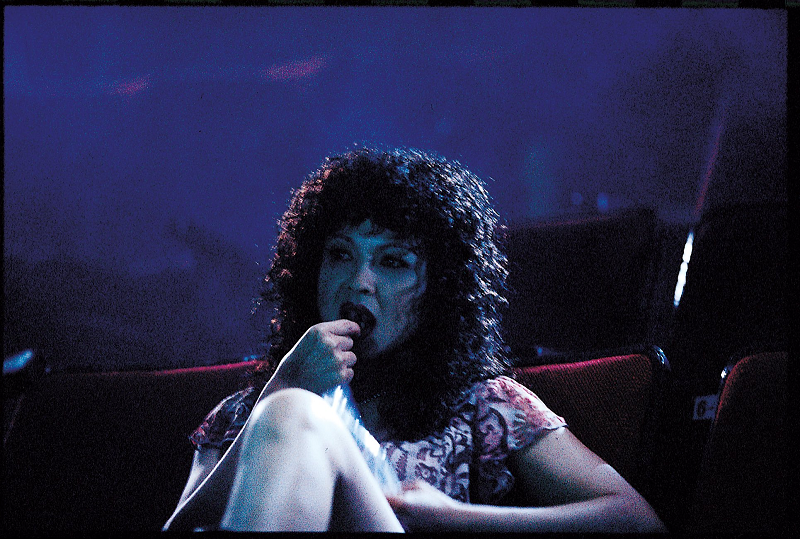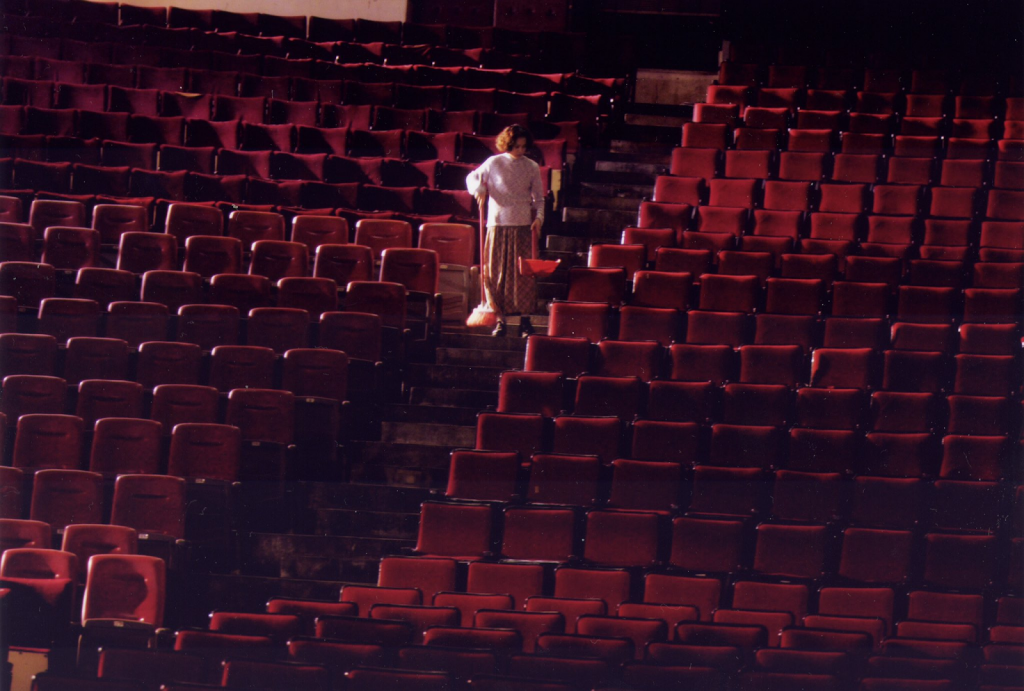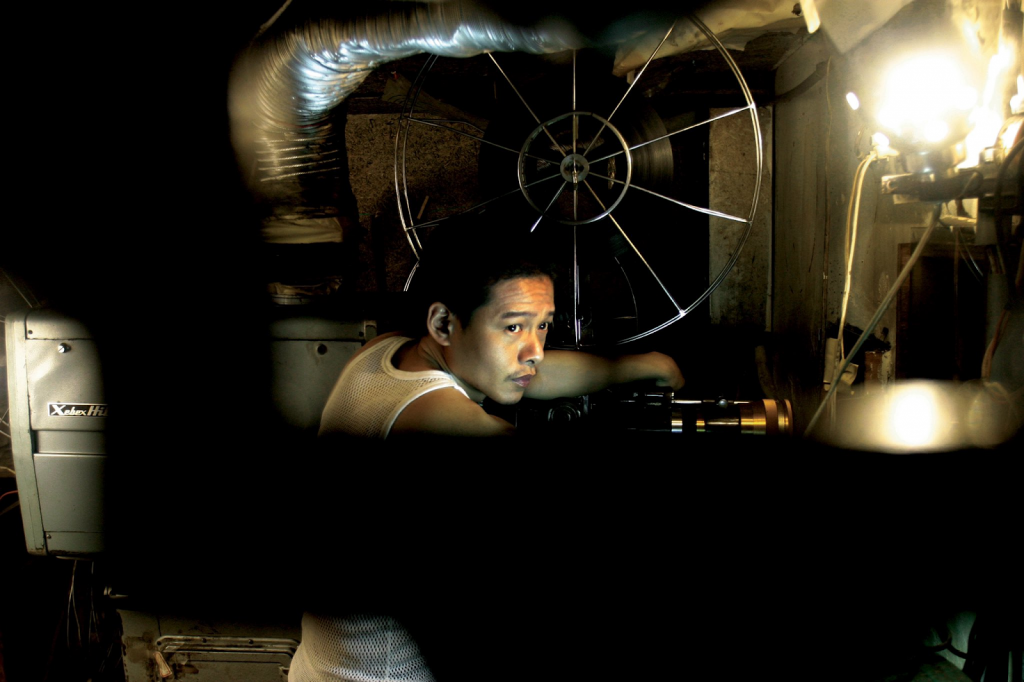
In Taipei, a movie theater is closing, but not before one final film is shown — “Dragon Inn,” a 1967 actioner and the source of nostalgia for the moviegoers and employees in the old, decrepit and possibly haunted building. The workers include eccentric projectionist Hsiao-Kang (Lee Kang-sheng) and a crippled cashier (Shiang-chyi Chen). The patrons include a Japanese tourist (Kiyonobu Mitamura) and two ghostly actors from the original film who have come to mourn the passing of an era.
| Reviewed by: Deepagcharan
Tsai Ming Liang’s Goodbye, Dragon Inn is an inventive piece of work; a true ode to cinema-going. The Malaysian-born Taiwanese filmmaker is widely recognised as a key player in Taiwanese New Wave filmmaking. Despite its runtime of 82 minutes, the lingering mood conjured by the film will resonate far beyond.
The film is a representative of the slow film counterculture, championed by directors such as Apichatpong Weerasethakul and Béla Tarr. These movies emphasise presenting a contemplative experience, frequently in languid long takes and devoid of a plot. Despite being an idiosyncratic experience, eventually, I grew to appreciate such films as it reframes your views on films, allowing you to be present in the moment.
Dragon Inn emphasises the rueful encounter that the audience has with cinema-going, it is presented in a pseudo-documentary format chronicling the moments from the last screening before cinema closure. The film is a culmination of the exposition of the cinema’s architecture and its diverse stakeholders — the moviegoers, the cinema manager, and the film projectionist.  Goodbye Dragon Inn 2 Despite having no interpersonal connections, the film’s characters, such as the Japanese tourist, the cinema manager, and the film projectionist, are connected by their shared geographical space — the community is underlined. The Japanese tourist looking for a chance encounter and the cinema manager despite having a physical disability is searching for the film projectionist to share her food, highlighting the idea of a safe space for them.
In essence, the film is about lamenting the cultural loss of going to the movies, but instead of adopting a sombre tone, Tsai presents it palatably with a tinge of melancholy by introducing a sardonic brand of humour, highlighting unpleasant moviegoing experiences such as a patron placing their bare foot on to the front seat and the loud chewing of a watermelon seed. Such scenes imply how the sacredness of cinematic space is violated and the notion of the communal experience of cinema. Simultaneously, viewers get to reflect on their own experiences and rekindle their memories of going to the movies.
The opening scene of the film, which is focused on the 1967 screening of King Hu’s Dragon Inn, depicts a packed theatre to transport the audience to the height of the moviegoing experience in the past. The film assumes the function of a bridge between the past and present as a result of the film screening. The lines between space and time become fuzzier as you reflect on the illustrious past of cinema presented in the form of a martial arts epic. Through the experience of watching on a giant screen, the spectator traverses from the present to the past.
While the original Taiwanese title, ‘Bu San’, roughly translated to “not departing”, may seem incongruous with its English title, Tsai walks on a tightrope between these seemingly contrasting ideas to suggest that either notion of bidding farewell and not wanting to go are indicative of the end’s impending phase. In attendance we witness the original cast of Dragon Inn, Miao Tien and Shih Chun, reminiscing their experiences of catching the film for the last time with tears in their eyes, the scene enhances the juxtaposition of the past and present state since they were actual casts of the film — a time travel indeed, evoking memories and experiences.  Goodbye Dragon Inn 3 Because static shots are used — it creates a visceral effect similar to viewing photographs — capturing a precise perspective and assisting viewers in acclimatising to the movie’s pace, simultaneously a window into the theatre. One sequence, in particular, is a static view that spans the entire, deserted theatre after the film screening has completed, for at least a few minutes. While some may be perplexed, it seemed as though the director was encouraging the audience to focus on each seat in the theatre and how each audience walks away with a different viewpoint. In some ways, the anticipated loss may be comparable to the cinema’s volume.
What relevance does a movie theatre have, especially if it’s a dilapidated structure where rain seeps in and it can’t withstand severe weather? It got me thinking about how we take art venues for granted and how architecture and our environment, in addition to living beings, also have a finite lifespan. We are being exposed to cinema as a time capsule, renouncing a narrative structure heightens the notion of chronicling a pivotal moment.The ephemeral quality of the present situation and the impact of loss at stake.
The film’s elegiac and contemplative atmosphere seems to be geared to inspire us, the audience, to think back on our own moviegoing experiences. Given that there has been a radical change in our behaviour toward movie consumption since the pandemic, this topic is much more pertinent for discussion. How can the movie industry remain relevant in the age of streaming services? And it also made me recollect and reflect on my memories of cinema-going experiences.
Tsai’s approach to filmmaking is certainly fascinating and the film is definitely bound to be divisive if it is visited from a conventional point of view. He slyly subverts the notion of time and his Dragon Inn is a film targeted at cinephiles who lament the yesteryear experience of single-screen cinema. _ Deepagcharan prefers MUBI over Netflix. He is constantly on the lookout for innovative voices and iconic films that have contributed to the history of cinema. |
Click Here For More Film Reviews
Do you love writing? Send us a film review and we will feature it on our website. Any film that people can see in the theater or online. Email to: media@scape.sg
This review is also published on Sinema as part of *SCAPE’s Film Critics Lab: A Writing Mentorship Programme.

